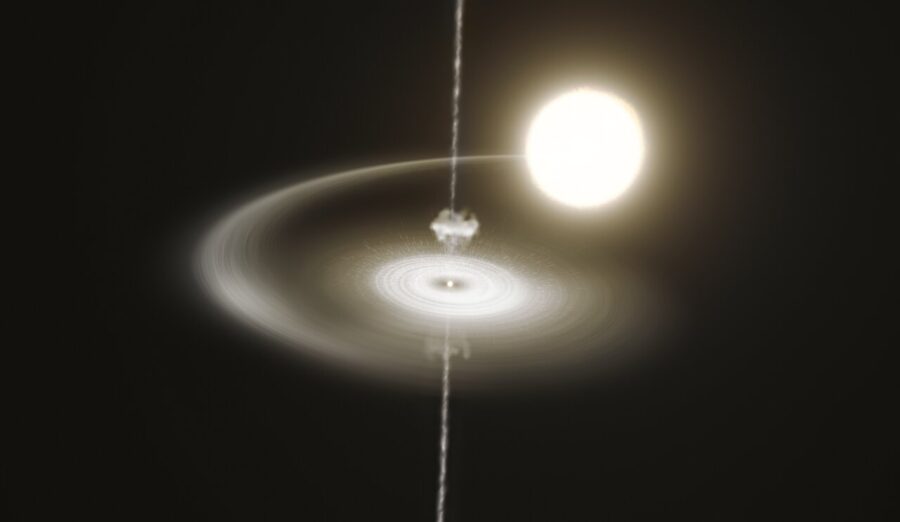Astronomers think a city-size star that’s spinning faster than a kitchen blender is shooting out plasma torpedoes.

ESO / M. Kornmesser
Astronomers think a city-size star that’s spinning faster than a kitchen blender is shooting out plasma torpedoes.
“We have witnessed extraordinary cosmic events,” says Maria Cristina Baglio (New York University Abu Dhabi and Italian National Institute for Astrophysics), “where enormous amounts of matter, similar to cosmic cannonballs, are launched into space within a very brief time span of tens of seconds from a small, dense celestial object rotating at incredibly high speeds.” Baglio led a study of that object, published in Astronomy & Astrophysics.
The object, known as pulsar J1023+0038 (J1023 for short), is the crushed core of a star 4,500 light-years away in the constellation Sextans. When astronomers first discovered it in 2007, they found it by its radio-wave pulses. Those radio waves came from a jet of plasma whose beam swept by Earth like a lighthouse as the pulsar spun.
But then, in 2013, the pulsar did something that put it on center stage — it stopped pulsing. At the same time, it started shining brightly across visible, ultraviolet, X-ray, and gamma-ray wavelengths. Follow-up observations revealed clear signs of material swirling around the pulsar. The stellar corpse was feeding.
Like many pulsars, J1023 has a companion, a tiny star with just a fifth of the Sun’s mass. It’s now siphoning mass off this companion, but in a highly irregular way. Sometimes the radiation from the swirling material brightens for tens of seconds to a few minutes, while other times, mere seconds later, the brightness may suddenly drop. Astronomers have dubbed these states “high” and “low,” respectively. The dizzying switches between them, every few seconds or minutes, are not observed in other pulsars.
The pulsar’s odd behavior caught astronomers’ attention, and J1023 became the subject of a worldwide observing campaign for two nights in June 2021. Twelve telescopes based not only all over the world but also in several orbits in space aimed their apertures toward the system.
In the first night alone, the pulsar switched from high to low and back again 288 times. The multiple-wavelength perspective on these changes provided crucial insight into what was going on. Perhaps the most important data point came from the Atacama Large Millimeter/submillimeter Array (ALMA) in Chile, which caught the system flaring right before a high-to-low mode switch.
When the pulsar is in a high state, Baglio and colleagues suggest, the gas flowing in from the companion star gathers around it in a puffy disk. The pulsar itself, meanwhile, is blowing away a wind of charged particles. These particles then slam into this swirling stellar material. The collision shocks the material, lighting it up.
But this isn’t a stable system. Eventually, the hot, inner material spirals in toward the pulsar and shoots away down its jet. This event, which releases the flare of radiation that ALMA caught, is the so-called “cosmic cannonball.” With the disk cleared out, the pulsar enters its “low” mode for several seconds until the companion star can donate more material. (Astronomers don’t call this mode of accretion “inefficient” for nothing — the pulsar isn’t gaining much mass throughout this process.)

Baglio et al. / Astronomy & Astrophysics 2023
This scenario, which awaits confirmation via further observations, has broader implications for more than just this peculiar pulsar. “The findings in this work will help understand the poorly known mechanisms of jet formation and launching in other astrophysical systems,” Baglio says. “This topic is among the most vibrant research areas in the field of high-energy astrophysics.”
 3
3









Comments
Yaron Sheffer
September 12, 2023 at 10:29 am
"We have witnessed extraordinary cosmic events, where enormous amounts of matter, similar to cosmic cannonballs, are launched into space within a very brief time span of tens of seconds from a small, dense celestial object rotating at incredibly high speeds.”
Me hope her intended audience was duly impressed. And why not? Neutron stars are, like, stunningly amazing. Can you imagine your own city spinning around at 590 times per second?! That would rip it apart. But a neutron star has a gravitational field a trillion times greater than Earth's, and that keeps it in one spherical piece.
Still, their paper reports a mass transfer rate of about a trillionth of a solar mass per year, so calling such "enormous" is quite debatable.
You must be logged in to post a comment.
skynr13
September 15, 2023 at 5:56 pm
The entire mass of our Solar system and is equal to the core of our Sun, 1/10th of 1% (.001) of the mass of the Sun. One trillionth is .0000000001, so the mass of the accretion is 1/100,000th of the total mass of our Sun. Which is about 3 Earth masses per year.
You must be logged in to post a comment.
Yaron Sheffer
September 20, 2023 at 10:09 am
I am confused. Did you just prove that 1 trillionth of the Sun equals 1 hundred-thousandth of the Sun? What kind of math is this?
You must be logged in to post a comment.
You must be logged in to post a comment.